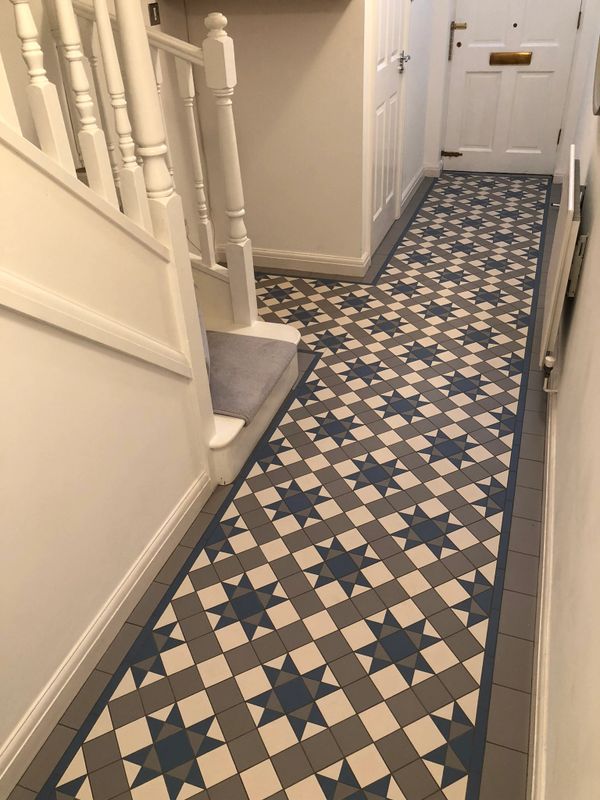Victorian Floors - Edwardian Floors - Period Floors
History of Period Floors

The Victorians certainly knew a thing or two about floor tiles. Their colourful geometric and encaustic tiles were not only beautiful, but hard-wearing and functional too.
The reproduction tiles used by The Victorian Floor Company are manufactured in very much the same way as they were in Victorian times. With a huge range of colours and shapes to choose from, they are perfect for period properties and add a touch of class to a more modern home.

The Cistercian monks originally produced clay floor tiles in the twelfth century and during medieval times no self-respecting abbey, monastery or royal palace in Britain would have been without a tiled floor. Following the dissolution of the monasteries in the 1540s floor tiles became less fashionable and demand diminished. The monks’ amazing skills might well have been lost forever.
However, at the beginning of the nineteenth century archaeological excavations of medieval sites around Britain and an increasing interest in medieval architecture led to the Gothic Revival – and with this pivotal change in architectural fashion came an increasing interest in, and demand for, all things medieval – including floor tiles.

But it wasn’t until the porcelain manufacturer Herbert Minton of Stoke revived the lost art of making encaustic tiles that the Victorians’ enthusiasm for floor tiles really took off.
Minton began experimenting in 1828 and in 1830 bought a half share in Samuel Wright’s patent for the production of encaustic tiles. By 1842 he was ready to supply his first major commission, for the Temple Church in London. He collaborated on this project with his friend, the architect Augustus Welby Northmore Pugin, who was a leading force in the Gothic Revival movement. Pugin was also working on the Houses of Parliament in London and soon he was specifying Minton tiles for the Parliament buildings as well as his many other prestigious projects at home and overseas.
Minton’s success was assured when Queen Victoria and Prince Albert commissioned him to make an encaustic pavement for Osborne House, their home on the Isle of Wight.

Unsurprisingly, it wasn’t long before a number of other manufacturers started to produce geometric and encaustic tiles, including Maw & Co, Daniel Platts and Minton Hollins (now part of H &R Johnson), all based in and around Stoke-on-Trent.
From the 1860s geometric and encaustic tiled floors became more and more popular as they appeared in an ever-growing number of churches, grand Victorian villas and public buildings, including the hugely popular Victoria and Albert Museum. By the 1890s, tiled floors and pathways had become an essential feature in even the most ordinary Victorian houses from Dover to Aberdeen.

Although it’s not likely that Victorian builders gave much thought to the longevity of their work, many geometric and encaustic tiled floors and pathways have survived over 150 years of wear white and tear. A walk around the nineteenth century terraced streets of Britain’s industrial towns and cities will quickly reveal examples of tiled garden paths and entrance steps, many looking as splendid today as they when they were first laid down.
Photo Gallery








Contact Us
Better yet, give us a call!
We love our customers, so feel free to call us for a chat during our normal business hours.
Hours
Taking calls between 8:00am and 8:00pm Monday to Saturday.
Copyright © 2024 Philip Adams Interiors Ltd Trading as The Victorian Floor Company - All Rights Reserved
Registered in England: Company number 12479207
- Home
- Design and Installation
- History of Period Floors
- Gallery
- Contact Us
- Period Flooring Cheshire
- Period Flooring Knutsford
- Period Floors Beeston
- Period Floors Long Eaton
- Period Floor Chesterfield
- Period Floors in Bakewell
- Period Floors Mansfield
- Period Floors in Stafford
- Period Floor Loughborough
- Period Floors Stratford
- Outdoor Victorian Tiles
Cookie Policy
This website uses cookies. By continuing to use this site, you accept our use of cookies.